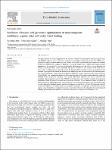Item Infomation

| Title: |
| Nonlinear vibration and geometric optimization of nanocomposite multilayer organic solar cell under wind loading |
| Authors: |
| Vu Minh Anh |
| Advisor: |
| Tran Quoc Quan Phuong Tran |
| Issue Date: |
| 2021 |
| Publisher: |
| Thin-Walled Structures |
| Abstract: |
| This paper presents an analytical approach on the nonlinear vibration of nanocomposite multilayer organic solar cell (NMOSC) subjected to the combination of wind load and uniform temperature change. The NMOSC comprises of five layers, which are made of Al, P3HT:PCBM, PEDOT:PSS, Graphene and Glass. Compared to common models of the NMOSC, ITO is replaced by graphene to control the output colors of NMOSC. The nonlinear motion equations and the compatibility equation are deriving by taking into account the effect of viscous damping, von Karman nonlinearity terms, elastic foundations and initial imperfection. The formula of the wind load is improved for consideration in the general case that the direction of the wind load is not just perpendicular to the structure. Four edges of the NMOSC are assumed to be simply supported and immovable in the transverse plane. The Galerkin and Runge – Kutta methods are applied to obtain the dynamic response and the natural frequency of the NMOSC. Four optimization algorithms (Bees Algorithm, Basic differential evolution algorithm, enhanced colliding bodies optimization algorithm, social group optimization algorithm) are used to determine the maximum value of natural frequency of the NMOCS, which depends on nine variables including the geometrical parameters, elastic foundations stiffness and temperature increment. In the numerical results, the effects of elastic foundations, initial imperfection, viscous damping ratio, temperature increment, wind load and the length to width ratio on the dynamic response and natural frequency are considered in details. The maximum values of the natural frequency of the NMOSC with four algorithms are obtained and compared. The results show that the optimal value obtained by four algorithms is close to each other. However, the calculation time with enhanced colliding bodies optimization algorithm is the fastest and with Bees Algorithm is the longest of all. |
| Description: |
| Q1 |
| URI: |
| https://www.sciencedirect.com/science/article/pii/S0263823120310715?via%3Dihub#! https://dlib.phenikaa-uni.edu.vn/handle/PNK/1953 |
| Appears in Collections |
| Bài báo khoa học |
ABSTRACTS VIEWS
162
FULLTEXT VIEWS
12
Files in This Item:
